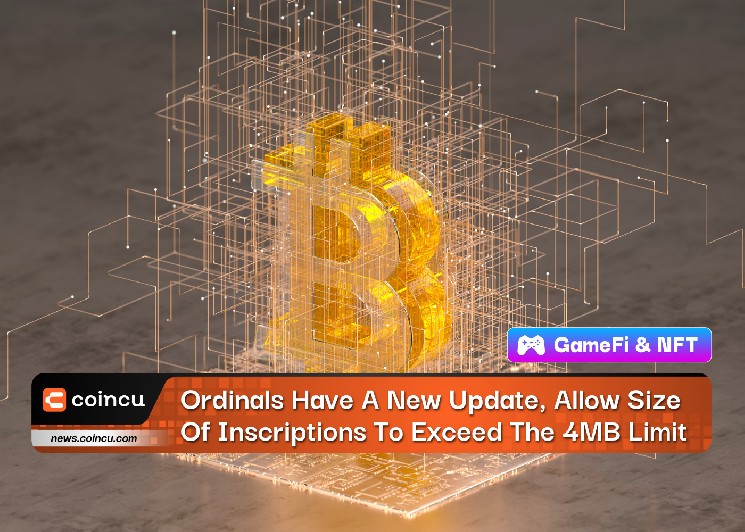Ordinals Have A New Update, Allow Size Of Inscriptions To Exceed The 4MB Limit

“Raphjaph”, the current principal maintainer of the Bitcoin protocol Ordinals, has incorporated Casey Rodarmor’s (the developer of the Bitcoin protocol Ordinals) “recursive inscriptions” No. 2167 upgrade into the Ordinals source on GitHub.
Inscriptions may now utilize the specific “/-/content/:inscription id” syntax to request material from other inscriptions, according to developer Leonidas.og. This small modification opens up a slew of new possibilities.
For example, rather than inscribing 10,000 JPEG files individually for a PFP collection (which would be prohibitively expensive), it would be preferable to inscribe 200 features from the collection, followed by 10,000 more inscriptions, each of which uses a small amount of code to request the features and render the image programmatically. Artwork is simply kept on-chain more efficiently, saving over $1 million in transaction costs in the instance of Bitcoin Apes.

Similar to BRC721, each inscription has the function of calling a function, the code for executing the function is solely in text format, and the volume is relatively tiny. As a result, even if the size of the individual inscription is less than 4MB, the entire inscription may surpass this restriction. Complicated 3D video games are completely on the Bitcoin blockchain.
Bitcoin Ordinals are a method for satoshis (individual Bitcoin units) to be numbered, named, and even engraved with data, converting them into non-fungible tokens (NFTs).
The Ordinals protocol is a technique for distinguishing and tracking individual sats, which is a necessary component for developing Bitcoin-based NFTs. As a new Bitcoin block is mined and new coins are minted as mining rewards, the system gives each sat a unique number depending on when it was mined. Smaller numbers indicate older sats.

An ordinal is really saved in a Bitcoin block, meaning the data is available as long as Bitcoin or any of its forks exist. It can only disappear if Bitcoin ceases to exist and every instance of the blockchain is wiped. It is almost impossible.
DISCLAIMER: The information on this website is provided as general market commentary and does not constitute investment advice. We encourage you to do your own research before investing.







 Bitcoin
Bitcoin  Ethereum
Ethereum  Tether
Tether  USDC
USDC  Dogecoin
Dogecoin  Cardano
Cardano  TRON
TRON  Bitcoin Cash
Bitcoin Cash  Chainlink
Chainlink  Polygon
Polygon  Litecoin
Litecoin  LEO Token
LEO Token  Dai
Dai  Ethereum Classic
Ethereum Classic  Hedera
Hedera  Stacks
Stacks  Cronos
Cronos  Stellar
Stellar  Cosmos Hub
Cosmos Hub  OKB
OKB  Maker
Maker  Theta Network
Theta Network  Monero
Monero  Algorand
Algorand  NEO
NEO  Gate
Gate  Tezos
Tezos  KuCoin
KuCoin  EOS
EOS  Synthetix Network
Synthetix Network  IOTA
IOTA  Bitcoin Gold
Bitcoin Gold  Tether Gold
Tether Gold  TrueUSD
TrueUSD  Enjin Coin
Enjin Coin  Zilliqa
Zilliqa  Ravencoin
Ravencoin  Holo
Holo  0x Protocol
0x Protocol  Siacoin
Siacoin  Qtum
Qtum  Basic Attention
Basic Attention  Dash
Dash  Zcash
Zcash  NEM
NEM  Decred
Decred  Ontology
Ontology  Lisk
Lisk  Waves
Waves  DigiByte
DigiByte  Status
Status  Numeraire
Numeraire  Nano
Nano  Pax Dollar
Pax Dollar  Hive
Hive  Steem
Steem  Huobi
Huobi  OMG Network
OMG Network  BUSD
BUSD  Ren
Ren  Bytom
Bytom  Bitcoin Diamond
Bitcoin Diamond  HUSD
HUSD  Kyber Network Crystal Legacy
Kyber Network Crystal Legacy  Energi
Energi  Augur
Augur